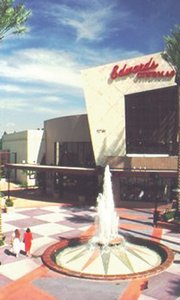Outdoor Retail Centers Take a Cue from Bigger Brothers
The symbol of urban sprawl—the strip mall—is getting a makeover.
With the emergence of outdoor lifestyle centers such as The Grove in Los Angeles and Victoria Gardens in Rancho Cucamonga, Calif., the standards for retail real estate have been raised and it’s trickling down to community shopping centers.
Community shopping centers, usually outdoor-based, between 30,000 and 250,000 square feet and anchored by supermarkets, drugstores or mass merchant retailers like Wal-Mart and Target, make up a good 42 percent (28 percent stand alone and 14 percent strip mall) of the retail marketplace, according to the National Retail Federation.
Retailers from off-price chains such as Ross Stores, Styles for Less and independents are attracted to them for their lower rents, built-in traffic and easy access.
The formula for these centers has been to make them cheap and fast, but obstacles such as Big Box ordinances and retail consolidation are providing new challenges.
Larger shopping centers have been setting the pace with a wave of renovations, turning 1970s-era enclosed malls into modern outdoor lifestyle centers with a heavy entertainment element. Bella Terra (formerly the Huntington Beach Mall) in Huntington Beach, Calif., The Block in Orange, Calif., and Victoria Gardens in the Inland Empire are some of the latest entries.
Developers of smaller community and neighborhood shopping centers, aka strip malls, are taking note.
“Shopping centers need to reinvent themselves every 10 to 12 years, and that’s what’s happening right now,” said Metre Anthony, redevelopment administrator for the city of Cerritos, Calif., which is close to finishing its Cerritos Town Center, an outdoor shopping and office complex based in southeast Los Angeles County.
Anthony said the Town Center is facing marketing challenges though its anchor, Wal-Mart, has been performing strongly. “It’s the smaller stores that need some help,” he said.
The strip-mall concept still holds lots of value, said Alan Clifton, vice president of leasing and disposition for Irvine, Calif.–based real estate firm Passco Companies LLC.
“They can get the same foot traffic as an [enclosed mall]. Here in Orange County, for example, you can pay $60 to $70 per square foot at Fashion Island or pay $15 to $18 at a community shopping center. It keeps the overhead down,” he said.
Real estate developers like the Irvine Co. saw the value in going upscale a long time ago. But more recently, it has undertaken a three-year, $70 million reinvestment endeavor for many of its older neighborhood shopping centers to keep up with trends.
At Culver Plaza in Irvine, for example, the company repositioned its restaurant tenants to a central location and installed an outdoor heated patio for dining.
“It’s made it more conducive to hanging out there a little longer,” said Irvine Co. spokesman Bill Rams.
Newer Irvine Co. projects such as Corona del Mar Plaza in Newport Beach, Calif., reflect a new modernism with lots of attention to design and details. The effort has lured tenants like Tommy Bahama, Jack’s Surfboards, Diane’s Swimwear and the popular Gulfstream restaurant.
Clifton said Corona del Mar’s strategy of luring diverse tenants like Jack’s and Tommy Bahama is effective because it attracts the entire family.
Leasing plays a strong part, added Rams. “We scout the hot spots all over the country whether in New York, Chicago or wherever for edgy cool businesses that can fit into our mix. Our team does a lot of work.”
Irvine Co.’s newest center is Woodbury Town Center in Irvine, expected to open in late 2006. The center, designed in European-style architecture to reflect residential neighborhoods, will have Ralphs, Home Depot and Walgreens as its anchor tenants.
The consolidating marketplace is challenging strip and community centers. If one anchor goes dark, it could spell disaster for piggybacking tenants, explained Clifton. The supermarket sector has been part of the consolidation activity, with Albertsons the latest example. The supermarket chain was recently purchased by a team of investors.
If a center doesn’t fill the space right away, it could lead to reductions in rents and more vacancies. Clifton explained that municipalities are taking note and are requiring stores that vacate buildings to wait until full occupancy before they can take up residence elsewhere.
Big Box ordinances indirectly aimed at curbing giant Wal-Mart Supercenters are setting limits on square footages in neighborhood shopping centers.
The problem, said Clifton, is that could also prevent more desired anchors, like a Lowe’s or Costco, from filling a need.























